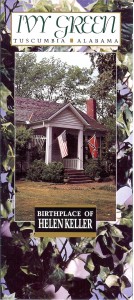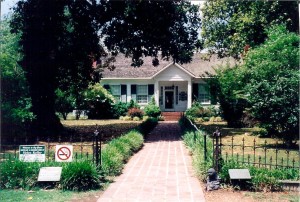Now that we were settled in a comfortable hotel in Cullman (I had hot tea with milk and sugar at the generous breakfast!), we decided to make it our base for northern Alabama, concentrating on the northwest this day. We had started to consider what we had not seen so far, so that we made a point to see these things before our trip came to an end. One thing that we wanted to visit but had so far not seen was a plantation. We had scoured the guidebooks and found nothing. Like the Confederate flags, plantations had eluded us. We were delighted to discover in our books that there was a plantation near Cullman, but were then disappointed to read that it was not open for the rest of our time in Alabama.
We headed to Tuscumbria to see Helen Keller’s house, the other landmark high on our priority list for the day. The house itself was not large, and an older woman toured us around. Unlike some of the guides we had previously encountered, this woman seemed very comfortable with my African-American traveling companion. In general, the northern part of the state seemed more racially relaxed than what we had encountered earlier in our visit. We suspected it was because we were moving into the mountains and out of the Deep South, so the legacy of slavery was less oppressive. We socialized with the other tourists as the day turned hot and humid. The mystery of the disappearing Confederate flags continued, as we found none at the museum, but one was prominently displayed on the brochure.
We began to speculate that somebody called ahead to warn them of the arriving northerners so they could take down the flag. All joking aside, we began to wonder about this disappearing emblem of the Confederacy. While we knew the display of it on public buildings was controversial, we expected to see it displayed on private property. Yet, we never saw it, and we began to wonder why. It intrigued us at the museum, which welcomed us to the experience of Helen Keller and her teacher, Annie Sullivan. Like Harper Lee’s hometown of Monroeville, Tuscumbria puts on regular performances of The Miracle Worker using hometown talent. Unfortunately for us, the play would not start until June. So begins my list of reasons to return to Alabama.
We continued on our way, heading to the northwestern corner of the state along the Trail of Tears. We hoped to find Waterloo, where Cherokees were shipped to Oklahoma and the Midwest under the Indian Removal Act of 1830. We had not been able to find it on our maps. We arrived at Florence around lunchtime and found a very quaint town where we searched for the only house in Alabama that had been designed by Frank Lloyd Wright. When we found it, we were disappointed that the heavy facade blocked so much of the glass house we hoped to find. I cannot even find a photograph of the structure in my records.
The next find made us considerably happier. Trowbridge’s Ice Cream and Sandwich Bar was the old school ice cream parlor we had been looking for throughout the trip. We walked around the quaint downtown of Florence looking at the historic homes and eating our orange ice cream with pineapple in it. We also sought out a historic tavern that our guidebook claimed had a museum inside. Unfortunately, we found it closed for the day, something that was becoming a frustrating pattern.
We headed out in search of Waterloo along the Trail of Tears, but got lost and never found it. Although we knew it was closed, we decided to visit Huston Plantation in Muscle Shoals, hoping that we could learn something just from visiting the grounds. The site itself was locked up, but it looked to us like a Hollywood set of an overgrown plantation. The only piece of the history accessible from outside was a plaque about the daughter of the person who owned it during the Confederacy. She went on to become a Red Cross nurse and provide aid and comfort to soldiers in the early 20th century. This was our first real miss of the trip, and we were disappointed. We would leave the South without visiting a plantation.
We moved westward, stopping to eat before we reached Natural Bridge, known for being the smallest populated town in Alabama. By the time we got there, the park accessing the longest natural bridge east of the Rockies was closed, and we began to feel conspicuous. We parked the car at the viewing area, and were greeted by a black cat with a missing tail who attempted to get in with us. The viewing area was closed, and when we turned around, an older pick up truck had materialized out of nowhere. The two people in it told us that the park was closed for the night. We left, feeling uncomfortable and concerned about our safety.
The drive home was too dark to take in the covered bridges we hoped to see, and we were happy when we arrived back in Cullman. I took a swim in the pool, my sole company a male guest who stood on his landing watching me as I lapped back and forth. I began to consider what I would do if he came down to the pool in the dark and tried to hurt me. I kept swimming anyway, and he eventually disappeared. Soon after, a busload of pilgrims headed for Mother Angelica’s convent in Irondale arrived, and I felt considerably safer watching the pilgrims mill about as their priest finished his cigarette in the parking lot.
It had been a good, but disappointing day, mostly because our timing was off. I am surprised to discover now that I have very few photographs from this particular day, not even ones of the gated plantation, Wright house, or charming Florence, which had been a highlight of the day. My fatigue shows through even 12 years later.


